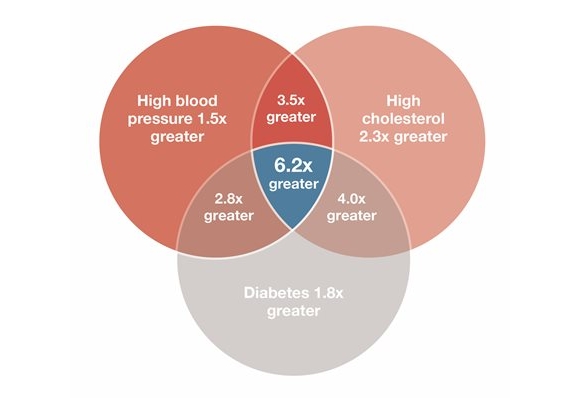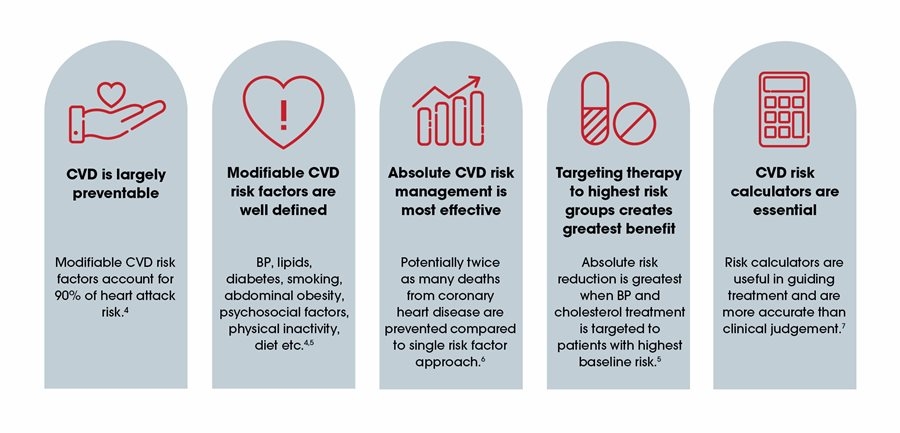Why assess absolute CVD risk?
Key stats and principles of the absolute CVD risk approach
Absolute cardiovascular disease (CVD) risk assessment brings together multiple risk factors to give an estimate of combined risk of heart attack or stroke in the next five years.
The burden of CVD remains high. CVD in Australia:
causes one in four of all deaths1
claims the life of one person every 13 minutes1
accounts for 1,619 hospitalisations per day2
It is estimated that one-fifth of Australian adults aged 45 to 74 years – or 1.4 million people – are at high risk of having a heart attack or stroke in the next five years.3
Modifiable CVD risk factors such as those mentioned above account for 90% of risk of heart attack, reinforcing the fact that CVD is largely preventable.
The absolute CVD risk approach
Absolute CVD risk assessment takes an integrated approach. It brings together multiple cardiovascular risk factors to give an estimate of the combined risk of experiencing a heart attack or stroke in the next five years (see Figure 1).
Creating even a moderate reduction in several risk factors is more effective in reducing overall CVD risk than a major reduction in a single risk factor alone.

Figure 1. An illustration of how individual CVD risk factors can combine to increase overall risk.
Since their launch in Australia in 2009, and update in 2012, the absolute CVD risk clinical guidelines have become the mainstay of treatment decision making for the primary prevention of CVD. However:
- there is still suboptimal assessment of risk factors
70% of high-risk individuals aged 45 to 74 years are not receiving guideline-recommended blood pressure and lipid lowering therapy.3
A planned approach using Heart Health Checks supports such interventions.
References
- Australian Bureau of Statistics. ‘Causes of Death, Australia, 2018’. 2019. https://www.abs.gov.au/statistics/health/causes-death/causes-death-australia/2018
- Australian Institute of Health and Welfare. National Hospital Morbidity Database (NHMD). 2020
- Banks E, Crouch SR, Korda RJ, et al. Absolute risk of cardiovascular disease events, and blood pressure- and lipid-lowering therapy in Australia. Med J Aust. 2016;204(8):320. doi:10.5694/mja15.01004.
- Yusuf S, Hawken S, Ounpuu S, et al. Effect of potentially modifiable risk factors associated with myocardial infarction in 52 countries (the INTERHEART study): case-control study. Lancet. 2004;364(9438):937–952. doi:10.1016/S0140-6736(04)17018-9
- National Vascular Disease Prevention Alliance. Guidelines for the management of absolute cardiovascular disease risk. 2021. https://www.heartfoundation.org.au/conditions/fp-absolute-cvd-risk-clinical-guidelines
- Manuel D, Lim J, Tanuseputro P, et al. Revisiting Rose: strategies for reducing coronary heart disease. BMJ. 2006;332(7542):659-62. doi:10.1136/bmj.332.7542.65.
- Jansen J, Bonner C, McKinn S, et al. General practitioners’ use of absolute risk versus individual risk factors in cardiovascular disease prevention: an experimental study. BMJ Open. 2014;4(5):e004812. doi: 10.1136/bmjopen-2014-004812.

Toolkit contents
Explore the list of pages in the Heart Health Check Toolkit for health professionals.

About the Toolkit
Supporting general practices to integrate Heart Health Checks into routine patient care, with a range of resources and easy-to-use tools in one place.

Downloadable resources
A full list of ready-to-use resources available in this Toolkit
Last updated21 March 2024
Last reviewed29 January 2024
